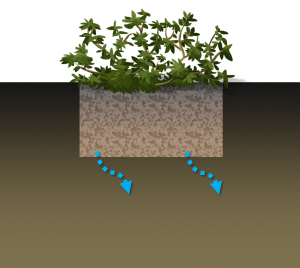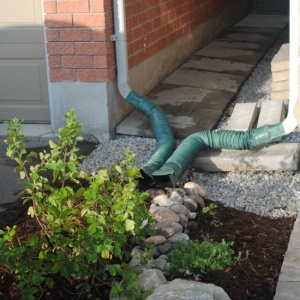Difference between revisions of "Rain gardens"
Alexveglio (talk | contribs) |
Alexveglio (talk | contribs) (→Design) |
||
| Line 21: | Line 21: | ||
==Design== | ==Design== | ||
===Plant Selection=== | ===Plant Selection=== | ||
The design of a rain garden allows for several different planting zones. | The design of a rain garden allows for several different planting zones. | ||
*A variety of plant material can be selected based on the desired aesthetic, including turf grass, ornamental grasses and perennial flowers, shrubs, and trees. | *A variety of plant material can be selected based on the desired aesthetic, including turf grass, ornamental grasses and perennial flowers, shrubs, and trees. | ||
| Line 50: | Line 38: | ||
'''Perennials/Grasses''' - 15 cm to #1 or 1 gal. container stock | '''Perennials/Grasses''' - 15 cm to #1 or 1 gal. container stock | ||
'''Ground Cover/ Vines''' - 10 cm to #1 or 1 gal. container stock | '''Ground Cover/ Vines''' - 10 cm to #1 or 1 gal. container stock | ||
====Hydric Zone Criteria==== | |||
{| class="wikitable" | |||
! Low Zone | |||
| Often referred to as the extended detention or shoreline fringe area. This area is frequently inundated during storm events, and is well-drained between rainfall events. | |||
|- | |||
! Mid Zone | |||
| Often referred to as the floodfringe area. This zone is inundated less frequently (2 – 100 year storm events) and has periodically high levels of moisture in the soil. The ecology of this zone is a transition from the Mineral Meadow Marsh/Beach-type community to an upland community. | |||
|- | |||
! High Zone | |||
| Often referred to as upland area. The ecology of this zone is terrestrial due to its elevation in relation to the filter bed. The zone most closely resembles a Cultural Meadow or a Cultural Thicket community, depending on the mix of grasses, herbaceous material, shrubs and trees utilized. | |||
|} | |||
==Incentives and Credits== | ==Incentives and Credits== | ||
Revision as of 20:18, 27 September 2017
This article is about planted installations designed to capture surface runoff in an amended soil.
For more highly engineered systems, see Bioretention cells.
Overview[edit]
Rain gardens capture roof, lawn and driveway runoff from low to medium density residential lots. These can be simple gardens constructed by the homeowner as a retrofit, or they can be professionally designed into a residential development.
Rain gardens are ideal for:
- Capturing the flow from disconnected downspouts
- Community design/build projects for raising awareness about stormwater capture and functional landscapes
The fundamental components of a rain garden are:
- An amended soil mix
- Suitable planting
Additional components may include:
- A splash pad of rocks to prevent the downspout flow from eroding the soil
- An overflow channel to another are of garden
Planning Considerations[edit]
Design[edit]
Plant Selection[edit]
The design of a rain garden allows for several different planting zones.
- A variety of plant material can be selected based on the desired aesthetic, including turf grass, ornamental grasses and perennial flowers, shrubs, and trees.
- The aesthetic can range from very naturalistic to quite formal, depending on the planting plan.
- Vegetation must also be capable of tolerating prolonged wet and dry periods unless an irrigation plan is in place
- If the facility is intended to be relatively inconspicuous, then the tallest plant material should be placed into the deepest part of the rain garden.
Since rain gardens are typically smaller scale homeowner projects smaller stock plants may be considered. Smaller containers may be easier to purchase, transport, and plant, but it may take longer to have a fully vegetated garden. Plant material per Canadian Standards for Nursery Stock, Eighth Edition. Seed planting is not recommended for rain gardens. Plants should be container grown, balled and burlapped or wire basket.
Below are recommended plant sizes for planting rain garden features:
Deciduous Shrubs - 60 - 80 cm height
Coniferous Shrubs / Broadleaf Evergreens - 40 cm spread (roughly #3 or 3 gal. container)
Perennials/Grasses - 15 cm to #1 or 1 gal. container stock
Ground Cover/ Vines - 10 cm to #1 or 1 gal. container stock
Hydric Zone Criteria[edit]
| Low Zone | Often referred to as the extended detention or shoreline fringe area. This area is frequently inundated during storm events, and is well-drained between rainfall events. |
|---|---|
| Mid Zone | Often referred to as the floodfringe area. This zone is inundated less frequently (2 – 100 year storm events) and has periodically high levels of moisture in the soil. The ecology of this zone is a transition from the Mineral Meadow Marsh/Beach-type community to an upland community. |
| High Zone | Often referred to as upland area. The ecology of this zone is terrestrial due to its elevation in relation to the filter bed. The zone most closely resembles a Cultural Meadow or a Cultural Thicket community, depending on the mix of grasses, herbaceous material, shrubs and trees utilized. |

